A Section Of Hubble’s Sharpest View Of The Andromeda Galaxy To Date, Taken Last Year.

A section of Hubble’s sharpest view of the Andromeda galaxy to date, taken last year.
source
More Posts from Study-astronomy-biology-ref and Others
Use studying techniques to your advantage:
Got these notebooks for 5 cents so obviously going to buy more than one :D # strongnotebookgameisstrong

There’s a method to my madness I swear!! OK so on avg I seem to use up two of those 80 pg notebooks so I got two for each class. And consequently I needed the 4pack 32pg exercise books.

The 80 page notebook is used for in class notes. As soon as anything important is said it is scribbled down into the notebook. The 4 pack 32 pg exercise book is divided to two groups: Feymann technique and Cornell method.
Feymann Technique
Right after class I grab my textbook, my notebooks and two of my exercise books. I teach myself the lesson primarily with my notes and if I don’t understand something I turn to my textbook. If I am still lost I leave space and note that there is something I need to clarify with my professor. Even while I am doing this, I force myself to decrease the writing and increase the connections between every topic since the 32 pg is quite smaller than the 80 pg.
Thankfully when I am done with this, my 32pg becomes the go to whenever it seems like I am in need of revising a topic since it contains relevant notes from both my textbook and my notebook in my own words.
Cornell Method.
When exam time approaches I convert my notes into the cornell notes so that I can easily test myself with the main ideas and key questions.
There is no better way to revise than to try to make connections. That is all you are going to get tested on since it’s not that hard to spit back words on a page. Instead of being asked about photosynthesis for example, you might be told about some chemical that is sprayed on a plant that will block one process and asked about how that affects the growth of the plant overall. See what I mean?

I usually get a whiteboard and write all of the connections out and in front of me. When THAT is done I write it down in flashcard mode and quiz myself for the next week using the Leitner system, along with the topics that are basically just memorization.
LEITNER SYSTEM

Label 5 boxes 1-4, where 1 is for cards you don’t know and 4 is for cards you are basically a pro in. You frequently test yourself in box 1 (maybe every 30 mins, you choose) and increase the time in which you test yourself until you reach 4, where you would test yourself just once a day.
In the beginning all of your cards go in box 1,and as you get a card right it goes up a level and if you get it wrong it goes down a level. That way you are spending more time with ideas and topics you don’t have a strong hold on, rather than spending equal time with all the topics.
At this point I have rewritten my notes twice in my own words and then converted them into flashcard mode :) I recommend this method when it comes to the sciences or humanities. For the maths I have already done a post about it here.
Hope this helps for those still looking for study techniques!
-F

Making your own personalised guides is quite different from your normal note-taking. Study guides are more exam-oriented, instead of merely summarising and organising information. It is a tool to help you to study for your exams, and to guide you through answering exam questions. This how-to guide is a summary of my learning experiences in both high school and college, so I hope this can help everyone here.
Goals for the study guides
It has to include everything on the syllabus for the examination
Omit things that are not going to be useful/helpful in exams
There are things that may be very informative, but if they have no relevance to the exam, it’s better to take them out of the study guide
Basically, the goal of making this study guide is to have one booklet/notebook that contain things you have learnt in that course, and most importantly, everything you need for the exam.
That means you (supposedly) wouldn’t have to refer to any other materials unless specified in the study guide
Making this booklet will help you to summarise and analyse information - a great way to study
Materials that you need
If you are in college, lecture notes are usually the most important material you should refer to when studying for exams. If you are in high school, textbooks are more likely to prevail. It depends on your course structure and the way your teacher/lecturer teaches.
Past papers / practice papers are great guidance for you when making study guides, because they help you to understand what will be on the exam paper, and most importantly, how you could answer the question.
Important tip: while making your own summary of the knowledge is useful, write down the model answer from the past paper in your study guide instead. That’s the way you should answer the question related to that topic in the exam, so you shouldn’t waste time putting in and memorising information that is not helpful.
For college students: tutorial questions usually offer great guidance as to what is going to appear in the exam. Putting those in the study guides is usually very helpful.
Organising the study guides
Here are a few tips when organising your notes:
Put a red star next to topics that you think are going to come up in the examination
Circle topics that you don’t understand / fail to grasp when making the study guides
Definitely use bullet points if possible
Highlight key words with definition in one specific colour, or anything that requires direct recitation
Because this is what you will study for the exam, also put down tips that are going to help you with the exams. (You can either draw a box to alert yourself or use a post-it note for these).
Answering structure / attack plan for common exam questions
Some common mistakes previous students made in the exam (which is usually brought up by the teacher / lecturer)
Important concept / clarification of misunderstandings
Remember to leave a page for each chapter and write a summary of it during revision
This will help you to understand the flow of the chapter and it is a great way to recall the information you have just organised
If you want to know more about how to take notes, here are some of my other posts:
A summary on how to take good lecture notes - #13
Type or write?
Type or write? updated + my approach
Should I take notes right now?
How to take outline notes?
Consolidating lecture notes and textbook notes
How to get better handwriting?
How to incorporate colours into note-taking and studying?

WOW!!
This computer-simulated image shows a supermassive black hole at the core of a galaxy. The black region in the center represents the black hole’s event horizon, where no light can escape the massive object’s gravitational grip. The black hole’s powerful gravity distorts space around it like a funhouse mirror. Light from background stars is stretched and smeared as the stars skim by the black hole.
Credits: NASA, ESA, and D. Coe, J. Anderson, and R. van der Marel (STScI)
Full Story at Hubble Space Telescope/NASA.- Behemoth Black Hole Found in an Unlikely Place
High-res images at HubbleSite.org
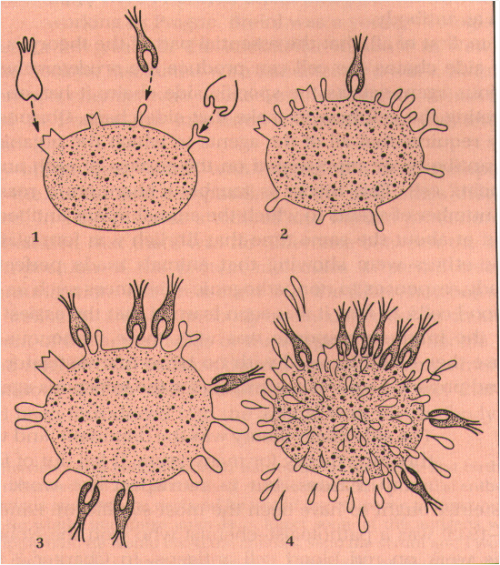
Antibodies are the secreted form of B-lymphocyte receptors and are a part of adaptive immunity, but how are these proteins formed?
Above is a diagram illustrating Paul Ehlrich’s Side Chain Theory of Antibody Formation. Ehlrich proposed that immunoglobulin molecules, a fundamental component of adaptive immunity, served as membrane bound proteins that bound to particular threats, similarly to the former “key in lock” view of enzymes in catalyzing biological reactions. Ehrlich also suggested that the action of binding a pathogenic molecule to the receptor would generate a signal to stimulate the production of more receptors of the same specificity. These “side chains” that were added on would then break off from the cell surface and become what we call antibodies.
We now know, however, that soluble immunoglobulin receptors are specially manufactured to be secreted as antibody, rather than just “breaking off” of the lymphocyte, even though they have the same specificity as their membrane-bound counterparts.




Bits and pieces of the Carina Nebula
A site of intense star formation, the Carina Nebula complex is home to some of the brightest and most massive stars in our Galaxy, the Milky Way.
This immense nebula contains a dozen or more brilliant stars that are estimated to be at least 50 to 100 times the mass of our Sun. The most rich and extensive one is the variable star Eta Carinae.
The visible-light view comes from the MPG/ESO 2.2-metre telescope at the La Silla Observatory and the infrared picture comes from the HAWK-I camera on ESO’s Very Large Telescope.
Credit: ESO
It’s Surprisingly Easy To Brew Something Like RNA In A Puddle
One of the biggest mysteries in science is how you could get life in a place where it doesn’t already exist. Scientists have found some clues, though.
The latest is that Georgia Tech chemist Nicholas Hud was able to create something that looks a lot like RNA — a relative of DNA — using ingredients that would have been common on Earth when it was 4 billion years younger.
The study used two common chemicals left alone in what amounts to a mud puddle. The chemicals synced up and started forming that twisting ladder shape we think of when we picture DNA.
Scientists say this looks like a decent candidate for how simple organisms may have gotten started on Earth, and it wasn’t even all that hard.
Earlier studies have shown you can get some of the building blocks of life in the right situation, like extreme heat or lightning strikes. Some have even been found on asteroids.
The Georgia Tech study shows you don’t even need that much excitement. Swirling puddles could potentially have done the job.
By: Newsy Science.
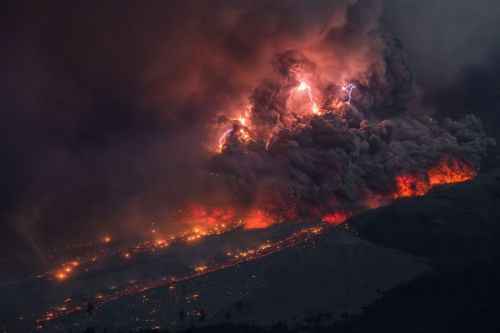

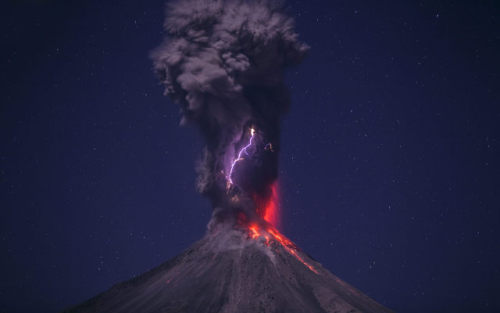
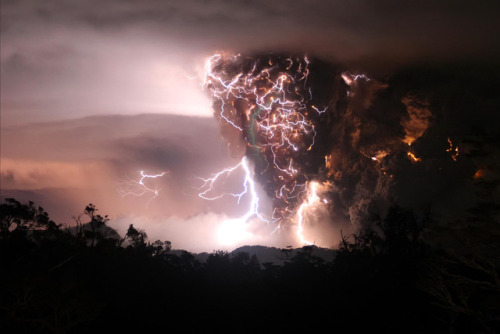
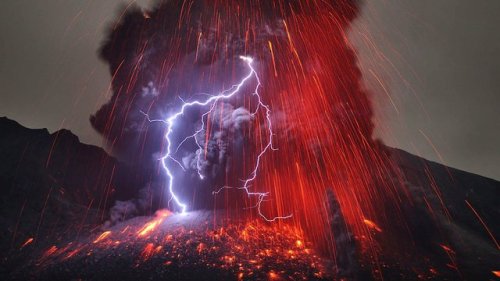
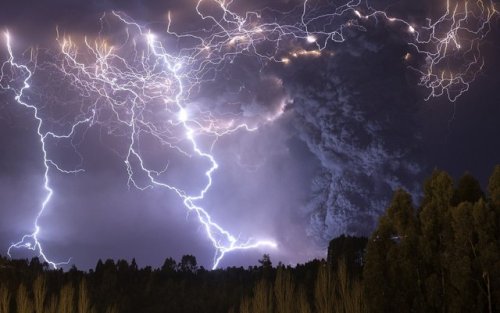
Dirty thunderstorm
A dirty thunderstorm (also volcanic lightning, thunder volcano) is a weather phenomenon that is related to the production of lightning in a volcanic plume.
A study in the journal Science indicated that electrical charges are generated when rock fragments, ash, and ice particles in a volcanic plume collide and produce static charges, just as ice particles collide in regular thunderstorms.
Volcanic eruptions are sometimes accompanied by flashes of lightning. However, this lightning doesn’t descend from storm clouds in the sky. It is generated within the ash cloud spewing from the volcano, in a process called charge separation.
source
images

Which U.S. state has banned some sunscreens from 2021, and why? ☀️ Find out in this month’s edition of #PeriodicGraphics in C&EN: https://ift.tt/2jSN4jl https://ift.tt/2JWdZ71
-
 cosmic-luxxe reblogged this · 8 years ago
cosmic-luxxe reblogged this · 8 years ago -
 quantumsuicidium-blog reblogged this · 8 years ago
quantumsuicidium-blog reblogged this · 8 years ago -
 staniswas reblogged this · 8 years ago
staniswas reblogged this · 8 years ago -
 like3buck reblogged this · 8 years ago
like3buck reblogged this · 8 years ago -
 lullabyformylover liked this · 8 years ago
lullabyformylover liked this · 8 years ago -
 rudewolfboi reblogged this · 8 years ago
rudewolfboi reblogged this · 8 years ago -
 rudewolfboi liked this · 8 years ago
rudewolfboi liked this · 8 years ago -
 powerocket reblogged this · 8 years ago
powerocket reblogged this · 8 years ago -
 limstee99 liked this · 8 years ago
limstee99 liked this · 8 years ago -
 asdfghjklwq reblogged this · 8 years ago
asdfghjklwq reblogged this · 8 years ago -
 mimosa-esplosa liked this · 8 years ago
mimosa-esplosa liked this · 8 years ago -
 liliumregale reblogged this · 8 years ago
liliumregale reblogged this · 8 years ago -
 dania-unicorn-blog reblogged this · 8 years ago
dania-unicorn-blog reblogged this · 8 years ago -
 saraphiels liked this · 8 years ago
saraphiels liked this · 8 years ago -
 faded-213 reblogged this · 8 years ago
faded-213 reblogged this · 8 years ago -
 petalo-de--sal liked this · 8 years ago
petalo-de--sal liked this · 8 years ago -
 colourfalls reblogged this · 8 years ago
colourfalls reblogged this · 8 years ago -
 colourfalls liked this · 8 years ago
colourfalls liked this · 8 years ago -
 c0smicdrift3r reblogged this · 8 years ago
c0smicdrift3r reblogged this · 8 years ago -
 edwinsan15 liked this · 8 years ago
edwinsan15 liked this · 8 years ago -
 setoflungs liked this · 8 years ago
setoflungs liked this · 8 years ago -
 sapunsapuncat liked this · 8 years ago
sapunsapuncat liked this · 8 years ago -
 miocielo reblogged this · 8 years ago
miocielo reblogged this · 8 years ago -
 uncommongeek liked this · 8 years ago
uncommongeek liked this · 8 years ago -
 kleeklutch liked this · 8 years ago
kleeklutch liked this · 8 years ago -
 2814something reblogged this · 8 years ago
2814something reblogged this · 8 years ago -
 unicorn-pinkypromise liked this · 8 years ago
unicorn-pinkypromise liked this · 8 years ago -
 thirdeyeexperiences-blog reblogged this · 8 years ago
thirdeyeexperiences-blog reblogged this · 8 years ago -
 the-cosmic-visitor reblogged this · 8 years ago
the-cosmic-visitor reblogged this · 8 years ago -
 scurci liked this · 8 years ago
scurci liked this · 8 years ago -
 boburnbabe reblogged this · 8 years ago
boburnbabe reblogged this · 8 years ago -
 pancakeentrepinuer23 liked this · 8 years ago
pancakeentrepinuer23 liked this · 8 years ago -
 sydthekid0092 reblogged this · 8 years ago
sydthekid0092 reblogged this · 8 years ago -
 qualitytrees reblogged this · 8 years ago
qualitytrees reblogged this · 8 years ago -
 stimmenfilter liked this · 8 years ago
stimmenfilter liked this · 8 years ago -
 iniwan reblogged this · 8 years ago
iniwan reblogged this · 8 years ago

This is a studyblr for everyone have some passion for science, especially astronomy and biology
129 posts







